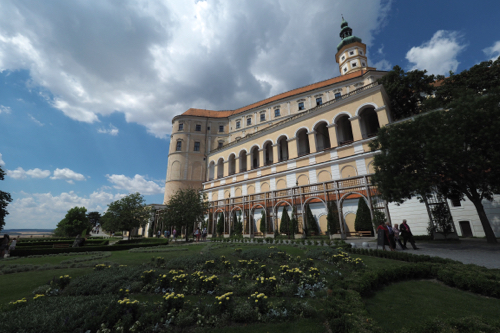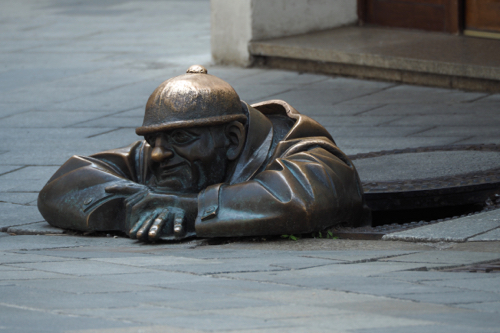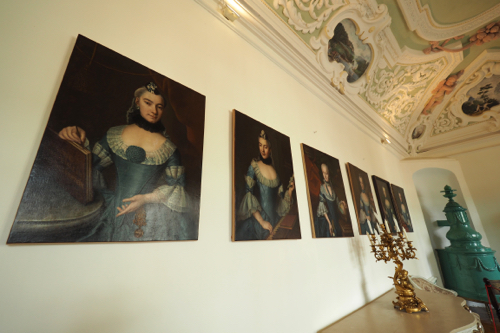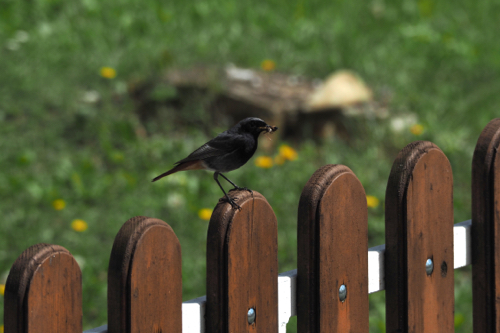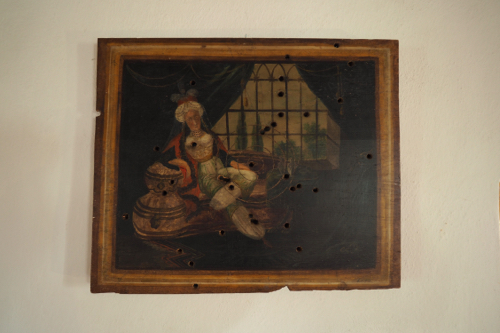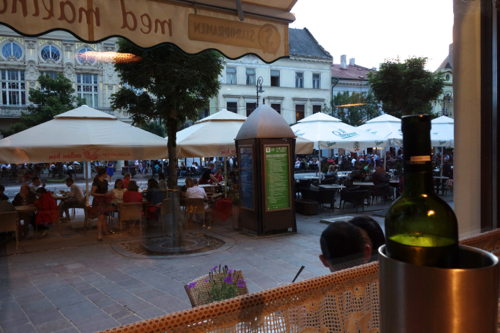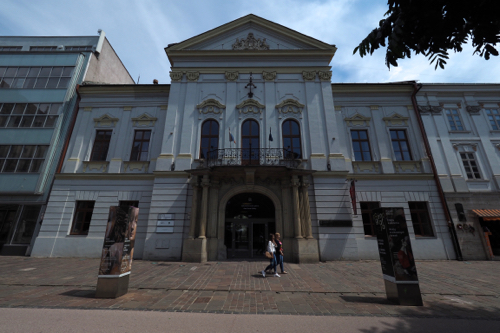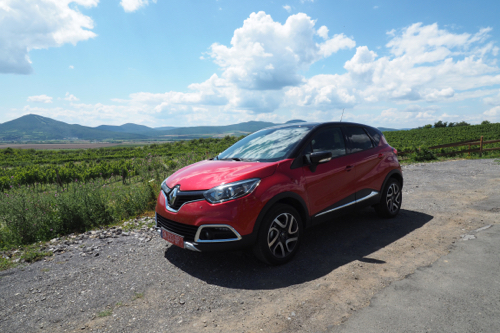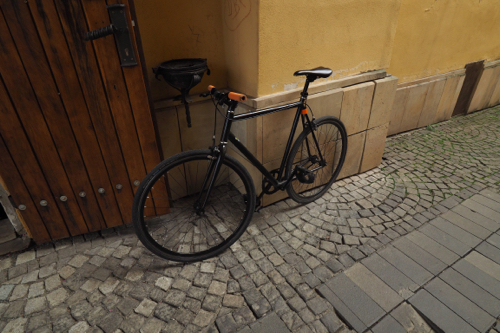July 8, 2017. Brno, Czech Republic to Bratislava, Slovakia.
After breakfast and a coffee with Kate and Mark we parted ways. They still had more touring to do in the Czech Republic and we were heading to Bratislava in Slovakia.
On the way we stopped in Mikulov, which is very close to the Austrian border. This small town is known for its architecture, with many buildings having Italian features.
Sitting above the town is Mikulov Castle. This reconstruction, built over the site of a 13th century castle, was built between 1719 and 1730 – it dominates the skyline.
Again weddings were everywhere. It was certainly a photogenic town and a great background for wedding snaps.
This is in the heart of the Moravian wine district and there were hundreds of locals, on push bikes, doing wine tours.
Just after we crossed into Slovakia we were forced to use the motorway, which was a toll road.
However just before the toll station there was an office where you could buy an electronic toll pass.
It was simple, relatively fast and saved all the hassle of having to find change at toll gates.
In fact there are no toll gates, so you have to have buy a pass.
We arrived in Bratislava mid afternoon, about the same time as the rain.
Our accommodation in Bratislava was at the Film Hotel. It was, as you might expect, about all things ‘film’.
There were human sized Oscars in the reception area, while the walls were covered in black and white photos of film stars, old and new.
Each room was named after an actor or actress, we were in room 9, Leonardo de Caprio.
We have been travelling for almost two months and this is our first new country on the itinerary.
July 9, 2017. Bratislava, Slovakia.
Bratislava is the only national capital that borders two sovereign states, Austria and Hungary.
It sits on the banks of the Danube and Morava Rivers. With a population of just over 450,000 it’s one of Europe’s smallest capital cities.
Bratislava was first mentioned in written history in 903. It became the capital of Slovakia, after the dissolution of Czechoslovakia, in 1993. Then, with the help of foreign investment, the economy took off.
In 2017 Bratislava was ranked as the third richest region in the European Union. It was certainly evident in the art, architecture, lifestyle and the people.
Street art is everywhere within the city centre. The one that got a lot of attention was a bronze sculpture of a worker emerging from a manhole.
In the afternoon we spent a few hours wandering around Bratislava Castle. This massive fortification stands above the city, overlooking the Danube River, on the Little Carpathians.
It dominates the city and has done so for centuries.
On a clear day you can actually see Austria and get a glimpse of Hungary. It wasn’t a clear day when we visited.
It was progressively built between the 9th and 18th centuries and rebuilt between 1956 and 1964, following a catastrophic fire in 1811.
Because of its location, within the centre of Europe, the site has been inhabited for thousands of years. First by the Celts and Romans and then by successive European dynasties.
The architectural style is a rich mixture of Gothic, Renaissance and Baroque. There is even an English park.
There was a glassware exhibition within the castle, celebrating 125 years of Rona in Bratislava. Rona was established in Ledniké Rovne, Slovakia, in 1892 and is famous for its unleaded drinking glasses.
Craft beer isn’t just in Germany and the Czech Republic, it’s crossed the border, and is well and truly established in Bratislava, Slovakia.
Over two days we found two craft brewpubs serving excellent craft beers. Both Zil Verne and Klubovña had a selection of imported craft beer, as well as their own brews.
However I don’t think they were serving their beer in Rona glassware.
July 10, 2017. Bratislava, Slovakia.
Bratislava was an interesting city, as was the Film Hotel, so we decided to stay an extra night.
Rather than moving on we made a day trip clockwise around the Bratislava area.
The main purpose, and highlight, was a side trip to the Red Stone Castle, which is between Píla and Častá.
Červený Kameň or Red Stone Castle was originally constructed around 1230 as a border castle between the Bohemian and Hungarian Kingdoms.
It has been home to many noble families, the last being Pálffy who were there from 1583 to 1945.
The beautifully crafted ceiling frescos in the living area were a feature.
Being designed as a fortress, the castle cellars were very impressive. The largest being 70 meters long, 7 meters wide and 9 meters high. The cellars are unique and the largest of their type in Europe, there’s even a 110 meter deep well.
Weather in this area is reliably unpredictable.
One moment there’s a blue sky, with patchy clouds. Then suddenly, all the clouds gang-up on you, and there’s a thunderstorm. After being here for a few days we realised that this is a regular afternoon occurrence.
No sooner had we arrived back at the Film Hotel than the thunder started to rumble. Which, by now, was to be expected.
On our last night in Bratislava we found yet another brewpub. Výčap U Ernöho is on a corner, just outside the city gates.
Just in front of the pub was a small square, which was well used by the pub patrons. They were chilling out in all styles of chairs and there was even a fountain and water spray to help cool the warm evening breeze.
They do know how to relax and they don’t have to pay a fortune for it.
A round of drinks (a large beer and wine) was €4.20 (A$6.50). We would be paying $20 in Hobsons.
July 11, 2017. Bratislava to Čičmany, Slovakia.
We made one stop on our way out of Bratislava and that was to see the Church of St Elizabeth.
Built in the Hungarian Art Nouveau style between, 1909 and 1913, this church is number six on the top ten sites of the city.
And it’s blue – very blue.
The exterior is covered in mosaics, much of them glass.
The vast majority of the drive to Čičmany was on a motorway. Then we got into the ‘slow-fast’ driving of the country roads. Slow through the villages, where the speed limit is 50 km/h and then a little faster through the countryside in between.
There were lots of villages so the going was slow, then occasionally fast.
We reached Čičmany in the early afternoon and were able to check into the hotel.
It was then off to explore the village.
Čičmany dates back to 1272 and is famous for its painted wooden houses. Which are much younger.
The houses date from the early part of the 20th century. The white motives painted on the black walls are inspired by the local embroidery.
Off to the side of the village, behind a group of trees, sits the the Baroque Church of the Elevation of the Holy Cross.
It didn’t take us long to explore Čičmany so we were glad we had only booked one night.
Our accommodation was at the Kaštieľ Čičmany. This was a traditional old house that had been completely renovated. It retained the old exterior but the inside had been made contemporary.
And all the furnishings came from Ikea, which was a refreshing change from all the ‘old world charm’ we had been experiencing.
The little village is surrounded by ski runs. So when it’s not hosting tourists in the summer, it’s full of skiers in the winter.
Not much is in English in Čičmany, so it is really catering to the local tourist trade.
It was obviously low season there as most places, that were open, shut early.
We found an ‘interesting’ local bar and restaurant down the road from our hotel. Come 9pm we were the only ones left in the place.
July 12, 2017. Čičmany to Banská Štiavnica, Slovakia.
On the way we stopped stopped at Bojnice Castle. This was first mentioned in history in 1013, when it was originally a wooden fort.
The most famous owner of the castle was János Ferenc Pálffy (1829-1908). He was a man who loved art, more than anything else. After a failed love affair he devoted his time, energy and money to the castle. He was one of the greatest collectors of antiques, tapestries, drawings, paintings and sculpture of his time.
The last independent owner was Ján Bata of Bata Shoes.
Ironically the Bata family were never mentioned in our guided tour. Which is surprising as the Bata Shoe story is a very interesting one. Maybe not the noblest of families but certainly one of the most industrious.
Founded over 122 years ago in the Czech Republic by Tomáš Bata, Bata Shoes have over 5,200 retail stores in more that 70 countries with production facilities in 18.
The family were originally cobblers, and to overcome a serious debt developed a new style of shoe made out of canvas.
They were one of the first shoe companies in Europe to industrialise, by installing steam-driven machines. They later introduced mass production techniques from America.
The Bata’s were the Henry Ford of shoes.
They received military orders during World War 1 but they fell into decline during the depression years that followed.
Rather than put off staff, the company reduced the price of their shoes and put their staff on a reduced salary. They also provided subsidies for their food and clothing.
They then gave their staff share options in the company, giving them added incentive to work hard and remain loyal.
This radical approach saw Bata Shoes actually increase market share during the depression and helped them to survive.
Many others went under.
The Family may not have collected art or built magnificent castles but they were certainly a family of great resolve and ingenuity.
Just as many Slovakian are early to bed, they are also late to rise. Well if our hotels in Čičmany and Banská Štiavnica were anything to go by.
The one in Čičmany didn’t start breakfast until 9am, while the Hotel Salamander, in Banská Štiavnica, didn’t start till 8am – how very civilised.
The Slovakian national summer pastime is eating ice cream. Everyone does it and they seem to do it with great regularity. I was so impressed with their ice-cream eating that I devoted an entire post to it.
Parking is always an issue in Europe but when you get into the small towns it gets worse.
In Banská Štiavnica we were staying in the Hotel Salamander.
They boasted parking.
When we arrived all but one of the five spots were taken. Apparently that was ours and it was partially on the street. So if any of the four cars in front of us needed to move, we would have to move, in order to let them out.
The solution was simple – just leave your keys at reception.
July 13, 2017. Banská Štiavnica, Slovakia.
We took the ‘Tourist Train’ around Banská Štiavnica. Unfortunately the commentary wasn’t in English as English speaking tourists don’t seem to have discovered this part of Europe. In fact most of the travellers seem to be either local or from bordering countries, such as Hungary, Poland, Austria and the Czech Republic.
Banská Štiavnica is a UNESCO World Heritage Site that’s built in a caldera.
It was first mentioned in history in 1157 and has been the centre of mining, especially during the Hapsburg Monarchy of the 18th century.
The oldest mining school in the Hungarian Kingdom was set up there in 1735 and in 1846 it joined with the Forest Academy which was founded in 1808. University and college buildings are dotted all over the city.
With its many attractions and relatively few tourists this area of Slovenia might just become a new ‘Hot Spot’ destination.
The Calvary of Banská Štiavnica was built in 1774, on the plug of the extinct volcano, which is in the centre of the caldera. It was under renovation, but its 23 monuments are worth the walk from town and the climb to get to the top.
The New Castle and the Old Castle are also worth a visit. The New castle has an interesting exhibition of Turkish artefacts and documents the history of the war with the Ottoman Empire.
It was built as a defence against Turkish invasion.
In the evening we found yet another brewpub, ERB. Edward Rada Breweries brew on the premises and also in an old synagogue, that’s just over the road.
The Synagogue was built in 1893 and was used as a place of worship until 1941.
It has been used for a number of business over the years, such as a sheet metal workshop and a driving school.
It has been a National Heritage site since 1955.
July 14, 2017. Banská Štiavnica to Košice, Slovakia.
This was the longest drive we had done for a few days.
And made even longer by us going down a new motorway, the wrong way, for quite a few kilometres.
The motorway was in the middle of nowhere and there were no turn-offs.
Arriving in Košice and finding our hotel wasn’t without its difficulties. The usual road works and one way streets hindered our way.
This is always going to be an issue when we chose hotels in the centre of the old town, which is usually pedestrian only streets.
The Hotel Zlaty Dukat is in one of the oldest buildings in Košice and built over the foundations of the old city wall. There is a staircase that descends to the basement, where there is a small wine bar built among the ruins.
After checking in we spent an hour or so just wandering.
Košice is the second largest city in Slovakia. The old town is concentrated along Hlavná (Street). This is a long walking area that’s dominated by St Elisabeth Cathedral, one of the largest Gothic churches in Europe.
There is a green area between the two walking streets. This is occupied with parents and children playing, two fountains, a glockenspiel and wedding photographers with their victims.
Restaurants line both sides but it’s hard to find one where people are eating an evening meal.
Most main meals seem to be taken at lunchtime, with pizza and cake being the staple in the summer twilight.
Maybe we should consider lunch as an option.
Košice was originally mentioned in history in the year 1230 and was the first settlement in Europe to be granted its own coat-of-arms in 1369.
July 15, 2017. Košice, Slovakia.
After a bit of housekeeping, AKA ‘washing’, we headed back into the old town.
The weather had threatened to be horrible but then turned out to be fine. Which meant the light was in the right position for most of the historic buildings.
We paid the ridiculously low price of €1, that was for both of us, and ventured below, into the old city fortifications.
They were from the 13th, 14th, 15th and 16th centuries, and 3 metres below the current city streets. Where we entered was the site of the original Lower or Southern Gate.
Later in the afternoon we climbed to the top of St Elisabeth’s Cathedral Tower to get a better view of the city.
The city sprawls off in all directions from the old section. Out in the ‘burbs the architecture was very 70s, Soviet high rise and not very interesting.
It did start to rain late in the afternoon but by that time we had seen all there was to see in Košice.
July 16, 2017. Košice to Viničky, Slovakia. (With a side trip into Hungary)
It was a day of ups and downs – literally.
The drive from Košice to Viničky was very short so we arrive very early and then headed out to explore the Tokaj wine region. We were at the very top of the wine trail as most of the region is in Hungary.
We managed, even at an early hour, to check into Pension Zlatá Putňa, so we had most of the day left to explore.
Most of the vineyards are tiny plots of land huddled around small villages.
There are the large commercial wineries but these are outnumbered by the small ones.
Out first stop was at the Tokaj Viewing Platform – our first up for the day.
The platform has been developed, with the help of some Swiss Francs, as a tourist attraction.
It’s 12 meters high and shaped like a wine barrel. It is certainly an interesting piece of architecture and was awarded so in 2015.
We then decided to make a side trip into Hungary. From the viewing platform we had sighted a cable car, and having nothing better to do, decided to try and find it.
One problem was that Hungary doesn’t use Euros, they have the Forint.
We managed to purchase tickets with our Visa card on the Nagas-hegyi Chair Lift and had our second up and down for the day.
We were in the Sátoraljaújhely area, which is an adventure playground for the locals, and they were there in their hundreds.
Apart from the chair lift there was a zip-line, cable car, stock car track and a strange style of toboggan run that was on rails.
We seemed to have been driving for kilometres but when we reached the top of the chair lift we could see Viničky, our village.
It was only about 8 kilometres away.
On our way back we stopped in Borsi to look at the castle. There wasn’t really much to see, as it was only a shell.
It seems its only claim to fame was that Ferenc Rákóczi II was born and lived there. Born in 1676 Ferenc Rákóczi is regarded as the hero of Hungary, leading the Hungarian uprising against the Hapsburgs between 1703 and 1711.
Our hotel was on the main road in Viničky and there wasn’t much else in the town.
Luckily the hotel had a restaurant.
We seemed to be the only people staying in the Penzión Zlatá Putňa but there were certainly a number of drop-ins, all local.
Thea had made enquiries about where we could have a local wine tasting.
The receptionist arranged for the chef to do a tasting with dinner, which all sounded very swish.
However it didn’t eventuate – apparently he was too busy.
July 17, 2017. Viničky to Prešov, Slovakia.
The next morning we didn’t seem to be expected for breakfast but it all happened, despite the confusion.
We were also told, by some guy we had never seen before, but seemed to carry some weight, that we could go into town and have a wine tastings there.
Apparently the family owned a cellar in Viničky and his uncle, Attila, would show us around.
It all seemed rather loose.
After breakfast we headed into Viničky for our cellar tour and tasting.
When we arrived at Zlatý Strapec, the wine cellar, nothing was open. After trying various doors, two women emerged from the adjoining building.
There seemed to be confusion as to why we were there.
We had a taste of the wine we had the previous night and we decided to buy two 500 ml bottles.
What else were we to do. We then headed back to our car.
Suddenly a guy turns up and tells us to come with him, to do the cellar tour. This turned out to be Attila, the uncle of they guy at the hotel.
Attila’s English was a little better than our Slovakian but he managed to communicate very well – especially with the help of Google Translate.
After our very weird but confusing cellar tour we went to the Zemplinska Śirava or Slovak Sea, as it is sometimes called. The reservoir dam was built between 1961 and 1965 and covers an area of 33 square kilometres.
This is a recreational area and there was a café, resort and a sandy beach. There were also a number of rather impressive sand sculptures just near the beach.
When we arrived in Prešov the hotel felt empty, in fact the entire town seemed to be empty. We were starting to wonder if the tourist season hasn’t even started yet.
July 18, 2017. Prešov to Poprad, via Spiš Castle and Spišsja Kaputula, Slovakia.
At breakfast there was only one other table – the hotel, like the town, was empty.
We were getting the feeling that the tourist season hadn’t really started yet in Eastern Slovakia.
When we got to Spiš Castle we found out where all the tourists were.
The place was overrun.
The car park was full and the overflow was lining the steep road leading up to the castle.
And when we purchased our entry tickets we were told that they had run out of Audio Guides.
Spiš Castle along with Calvery at Spišsja Kaputula are UNESCO World Heritage sites.
It is one of the largest castle sites in Europe with an area of 41,426 square metres.
This Medieval Castle was first mentioned in history in 1249 and then destroyed by fire in 1780.
From that point forward it fell into ruin.
There isn’t much left today, although there was an attempt at a partial reconstruction before 1993.
There are still remains left of those works that were done just after the break up of the Soviet Union.
The best views of the castle are from below, looking up. However it does have a small museum and chapel in the reconstructed castle tower.
We arrived at Poprad, at the foot of the High Tatra Mountains, at 3:30pm.
The weather was being its usual cantankerous self and the dark clouds were building.
July 19, 2017. Poprad-Spišská, with a side trip to Dobšinská Ice Caves, Slovakia.
The main destination for the day was to the Dobšinská Ice Caves, which was 33 kilometres south of Poprad.
We again discovered where all the tourists were – they visit castles and caves.
At the ice caves we had to pay for everything. Parking was €3, the tickets were €7 (with seniors discount) and the toilets €0.50.
However the most outrageous cost was €10 to take photos.
This UNESCO World Heritage site is part of the Caves of the Aggtelek Karst and Slovak Karst site.
They were discovered in 1850 by Eugen Ruffinyi, a mining engineer. Although they have been known by shepherds and hunters since time immemorial.
They were known as Studená Diera or Cold Hole.
They are regarded as one of the most important cave systems in the world and have been in existence for an estimated 250,000 years.
Once you have parked your car, and paid the fee, there’s about a 20 minute hike up to the entrance. The temperature was in the mid 20s for the climb up, but plummeted to zero once we got inside the caves. It certainly was a cold hole.
There was no English speaking guided tour so we joined in on the end of a Slovak one. We didn’t understand a word, which gave me the opportunity to hang back and take photos. At €10 each we decided to buy only one ticket to take snaps.
Apparently there has to be a minimum of 30 people to have a specific language guided tour.
Thea and I were the only English speakers, so we didn’t count as a group.
The caves are only open four and a half months of the year from May 15 to September 30. So I guess they have to make their money while they can.
The rest of the day was spent driving through the mountains.
By mistake, or good fortune, we ended up staying in Poprad-Spišská, not Poprad.
This was about 1.5 kilometres away from the downtown area of the main city.
It was built around a long, tree lined, square. There was a church at one end and old historic homes on either side.
There was also a surprising number of restaurants in this small area.
We booked three nights in the Boutique Hotel Fortuna and this gave us the opportunity to do two day trips.
One to the Dobšinská Ice Caves and another to the High Tatras.
July 20, 2017. Poprad-Spišská, with a trip to the High Tatra Mountains, Slovakia.
We initially headed to Vysoké Tatry for our Hight Tatra experience but it was far too crowded and the parking scalpers were everywhere.
We then drove down the road to Tatranká Lominica, where parking was free and the cable cars and chair lifts were open. We went as far up Mt Ve’ká Lomnická veža as we could, which was about 2,200 metres.
We would have liked to go to Lomnickŷ Štit, which is at 2,558 metres, but that cable car was completely booked out.
It was crowded but a very pleasant climb along the ridge that runs from the end of the chair lift.
After our walking in the mountains, we went driving in them as well.
First to Štrbské Pleso, then to Tatranká Štrba and finally back to Poprad-Spišská.
It was a very pleasant day in the fresh air, without a church in sight.
